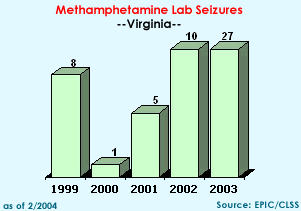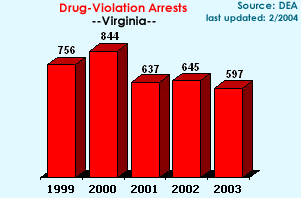|
 |
 DEA
Offices & Telephone Nos. DEA
Offices & Telephone Nos.
Bristol—540-466-8802
Hampton—757-825-5799
Norfolk—757-441-3152
Richmond—804-627-6300
Roanoke—540-857-2555
Winchester—540-662-5879 |
State
Facts
Population: 7,187,734
Law Enforcement Officers: 22,966
State Prison Population: 52,000
Probation Population: 40,359
Violent Crime Rate
National Ranking: 35 |
2003
Federal Drug Seizures
Cocaine: 32.5 kgs.
Heroin: 6 kgs.
Methamphetamine: 12 kgs.
Marijuana: 50 kgs.
Ecstasy: 4,095 tablets
Methamphetamine Laboratories: 27 (DEA, state, and
local) |
Drug
Situation:
Historically,
the mid-Atlantic region has served as a thoroughfare for drugs, drug-related
proceeds, weapons and other contraband traveling
along the east coast of the United States. Virginia cities situated along
Interstate-95 are vulnerable to "spillover" drug distribution
from traffickers moving between the two major eastern drug importation
hubs of New York City and Miami. Cocaine, crack cocaine and the violence
attendant with the trafficking of these drugs are the most significant
drug problem in the state, according to most law enforcement sources.
However, MDMA abuse and distribution is an already large and still-growing
problem, seizures of clandestine methamphetamine laboratories increase
every year, and Mexican trafficking organizations are making enormous
inroads in the cocaine, methamphetamine and marijuana distribution markets
in nearly every part of the state.
 Cocaine: Cocaine
in both powder and crack forms is prevalent throughout the state of
Virginia, in both wholesale and retail quantities. Considerable levels
of violence continue to be associated with the crack cocaine trade
in urban areas. Colombian and Dominican drug trafficking organizations
in New York City remain the primary sources for most of the cocaine
available in Virginia. Nonetheless, many local traffickers are becoming
more reliant on Mexican sources of supply in the southwestern U.S.,
North Carolina and Georgia. Cocaine: Cocaine
in both powder and crack forms is prevalent throughout the state of
Virginia, in both wholesale and retail quantities. Considerable levels
of violence continue to be associated with the crack cocaine trade
in urban areas. Colombian and Dominican drug trafficking organizations
in New York City remain the primary sources for most of the cocaine
available in Virginia. Nonetheless, many local traffickers are becoming
more reliant on Mexican sources of supply in the southwestern U.S.,
North Carolina and Georgia.
 Heroin:
The Richmond and Tidewater areas of Virginia
both boast a consistent, long-term heroin abuse population. Pockets
of heroin distribution
are present in other areas of the state as well, but the problem
is less pronounced. In recent years, "experimental" use
of heroin by younger drug users was on the rise, but appears to have
stabilized. Most of the heroin encountered in Virginia tends to be
of higher-than-average purity. In the Norfolk area, heroin is packaged
primarily in gelatin capsules, while it is packaged in small, usually
colored or marked, ziploc baggies in other parts of the state. Heroin:
The Richmond and Tidewater areas of Virginia
both boast a consistent, long-term heroin abuse population. Pockets
of heroin distribution
are present in other areas of the state as well, but the problem
is less pronounced. In recent years, "experimental" use
of heroin by younger drug users was on the rise, but appears to have
stabilized. Most of the heroin encountered in Virginia tends to be
of higher-than-average purity. In the Norfolk area, heroin is packaged
primarily in gelatin capsules, while it is packaged in small, usually
colored or marked, ziploc baggies in other parts of the state.
  Methamphetamine:
Although still minimal, localized clandestine
manufacture of methamphetamine has increased in Virginia every year for
the past several years, with
most of the activity centered on the far southwestern corner of the state
bordering West Virginia, North Carolina and Kentucky. The Shenandoah
Valley region contains the highest percentage of methamphetamine abusers
in the state, and was the first area of the state to receive a huge influx
of Mexican immigrants, whose presence encouraged an expansion of existing
Mexican drug-trafficking networks. In rave and nightclub venues, both "ice" and
methamphetamine have become drugs of choice. Methamphetamine:
Although still minimal, localized clandestine
manufacture of methamphetamine has increased in Virginia every year for
the past several years, with
most of the activity centered on the far southwestern corner of the state
bordering West Virginia, North Carolina and Kentucky. The Shenandoah
Valley region contains the highest percentage of methamphetamine abusers
in the state, and was the first area of the state to receive a huge influx
of Mexican immigrants, whose presence encouraged an expansion of existing
Mexican drug-trafficking networks. In rave and nightclub venues, both "ice" and
methamphetamine have become drugs of choice.
 Club
Drugs: Of the club drugs
widely abused and available within Virginia, MDMA is by far
the easiest to obtain and most
in demand. Once limited to abuse among teen and young-adult "ravers" from
the affluent Washington, DC suburbs, MDMA is now a drug of choice
among young adult drug users throughout the state, regardless
of socio-economic and ethnic background. GHB and Ketamine are
also widely available but, unlike MDMA, tend to remain within
the nightclub/rave community. Other hallucinogenic and stimulant
drugs, such as the piperazines, psilocybin mushrooms, LSD and
PCP are also available, with their abuse tending to exhibit
cyclical patterns or be limited to particular venues and/or
events. Club
Drugs: Of the club drugs
widely abused and available within Virginia, MDMA is by far
the easiest to obtain and most
in demand. Once limited to abuse among teen and young-adult "ravers" from
the affluent Washington, DC suburbs, MDMA is now a drug of choice
among young adult drug users throughout the state, regardless
of socio-economic and ethnic background. GHB and Ketamine are
also widely available but, unlike MDMA, tend to remain within
the nightclub/rave community. Other hallucinogenic and stimulant
drugs, such as the piperazines, psilocybin mushrooms, LSD and
PCP are also available, with their abuse tending to exhibit
cyclical patterns or be limited to particular venues and/or
events.
 Marijuana:
Marijuana is the most widely abused drug in the state of Virginia. Most
of the marijuana available in the state is commercial grade product,
imported from the southwestern U.S. Demand for high-grade marijuana,
however, is at extremely high levels with source areas ranging from
the Pacific Northwest to the New England states. Outdoor marijuana
cultivation flourishes during the spring and summer, and indoor grows
are increasingly common. Hydroponic indoor grows have not been encountered. Marijuana:
Marijuana is the most widely abused drug in the state of Virginia. Most
of the marijuana available in the state is commercial grade product,
imported from the southwestern U.S. Demand for high-grade marijuana,
however, is at extremely high levels with source areas ranging from
the Pacific Northwest to the New England states. Outdoor marijuana
cultivation flourishes during the spring and summer, and indoor grows
are increasingly common. Hydroponic indoor grows have not been encountered.
 OxyContin
and Other Prescription Drug Diversion:
Virginia
is one of the half-dozen or so states commonly cited by law enforcement
and medical
practitioners when discussing the national
OxyContin abuse "epidemic." Indeed, Virginia was one of the
first states to record extraordinary levels of OxyContin diversion and
abuse. Although abuse of the prescription painkiller was initially limited
to users in the southwestern portion of the state, that abuse has spread
to include most of western Virginia and much of central and northern
Virginia as well. Sources for diverted OxyContin are located both within
and outside of Virginia's borders. The diversion and abuse of other prescription
drugs has a long history in Virginia, particularly in the southwestern
portion of the state. OxyContin
and Other Prescription Drug Diversion:
Virginia
is one of the half-dozen or so states commonly cited by law enforcement
and medical
practitioners when discussing the national
OxyContin abuse "epidemic." Indeed, Virginia was one of the
first states to record extraordinary levels of OxyContin diversion and
abuse. Although abuse of the prescription painkiller was initially limited
to users in the southwestern portion of the state, that abuse has spread
to include most of western Virginia and much of central and northern
Virginia as well. Sources for diverted OxyContin are located both within
and outside of Virginia's borders. The diversion and abuse of other prescription
drugs has a long history in Virginia, particularly in the southwestern
portion of the state.
 DEA
Mobile Enforcement Teams: This cooperative program with state
and local law enforcement counterparts was conceived in 1995 in response
to the overwhelming problem of drug-related violent crime in towns and
cities across the nation. There have been 409 deployments completed resulting
in 16,763 arrests of violent drug criminals as of February 2004. There
have been nine Washington Division Mobile Enforcement Team (MET) deployments
in the State of Virginia since the inception of the program: Manassas,
Chincoteague, Fredericksburg, Richmond, Petersburg, Hampton, Prince William
County, Hopewell, and Shenandoah Valley. DEA
Mobile Enforcement Teams: This cooperative program with state
and local law enforcement counterparts was conceived in 1995 in response
to the overwhelming problem of drug-related violent crime in towns and
cities across the nation. There have been 409 deployments completed resulting
in 16,763 arrests of violent drug criminals as of February 2004. There
have been nine Washington Division Mobile Enforcement Team (MET) deployments
in the State of Virginia since the inception of the program: Manassas,
Chincoteague, Fredericksburg, Richmond, Petersburg, Hampton, Prince William
County, Hopewell, and Shenandoah Valley.
DEA
Regional Enforcement Teams:
This program was designed to augment existing DEA division resources
by targeting drug organizations operating in the United States where
there is a lack of sufficient local drug law enforcement. This Program
was conceived in 1999 in response to the threat posed by drug trafficking
organizations that have established networks of cells to conduct drug
trafficking operations in smaller, non-traditional trafficking locations
in the United States. Nationwide, there have been 22 deployments completed
resulting in 608 arrests of drug trafficking criminals as of February
2004. There has been one RET deployment in the State of Virginia since
the inception of the program: Portsmouth.
Other
Enforcement Operations:
The Washington/Baltimore HIDTA and Metropolitan Area Task Force (MATF)
both participate in and assist in the funding of enforcement groups in
northern Virginia. Northern Virginia is further served by an interdiction
task force covering Reagan National Airport, Dulles International Airport,
and the Amtrak train station in Alexandria.
Special
Topics: The Annandale High Intensity
Drug Trafficking Area (HIDTA)/MATF is comprised of two DEA task forces.
Seven local agencies
and the State Police are represented. On the federal level, the FBI provides
three Special Agents. Housed within the same office space is a joint
IRS/Secret Service money laundering group. Analytical support is provided
by intelligence analysts assigned to the Washington Field Division’s
Intelligence Group 31.
More information
about the Washington Division Office.
Sources
Factsheet
last updated: 2/2004
Click
here for last year's 2003 factsheet>> |

